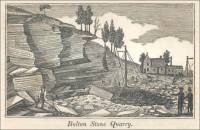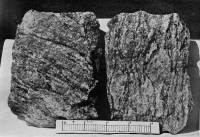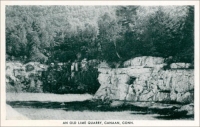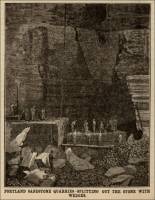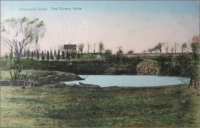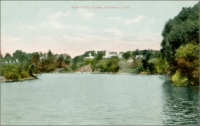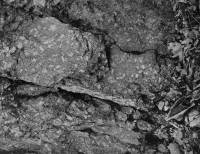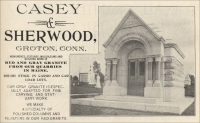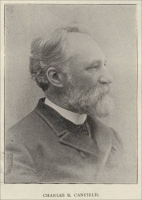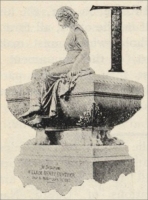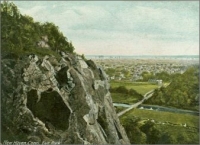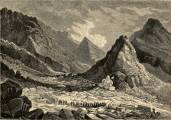
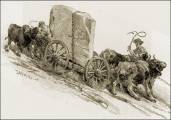

List of Quarries in Connecticut & Quarry Links,
Photographs and Articles
- Map - Preliminary Geologic and Economic Map of Connecticut.
(The following list of Connecticut quarries is not a complete list of all of the historical quarries in the state, only the ones I have been able to locate. Also, please see the section above entitled, "List of Connecticut Quarries from Printed Sources." If you know of more historical quarries in Connecticut, please contact me. Peggy B. Perazzo)
- Quarries in Connecticut (present-day companies), listed on Superyellowpages.com.
- An Aboriginal Soapstone Quarry (American Indian) (February 1893) (Locations mentioned are near Bristol, Connecticut; in Rhode Island; and in West Virginia.) The Manufacturer and Builder, Vol. 25, Issue 2, February 1893, pg. 38. (Article in digital images viewed at American Memory, Library of Congress.)
- Bolton, Connecticut – the Bolton Stone Quarry (engraving from Historical Collections of the State of Connecticut containing A General Collection of the most Interesting Facts, Traditions, Biographical Sketches, Anecdotes Etc. relating to its History and Antiquities, with geographical descriptions of every township in the state, John W. Barber, 1836.)
- Bolton, Connecticut - the Bolton Stone Quarry – “Bolton Flagging,” in Scientific American, January 31, 1885. (Slate quarrying and flagging in the Bolton Range in Connecticut)
- Bolton, Connecticut - Slate Quarries from The Settling of Bolton – Special Edition Celebrating Bolton’s 275th Anniversary - October 1995, Edited by Don Costello, web site created and maintained by Eileen G. Stanley. (The following quote is presented with the permission of the web master of the site.) “Among the more significant aspects of Bolton's developing economy were its quarries, which provided exceptionally good flagging slate for major cities on the east coast. The stone was extracted from the hills at the notch, and it was shipped out in the early 1800s, but it became even more important when the Hartford, Providence, and Fishkill Railroad came through in 1849.”
- Branford, Connecticut - Photograph A.
The caption reads: "Showing the lenticular shape of the feldspars and the distribution of the mica and quartz in bands. The large lenses are mostly microline feldspar."
- Branford & Stamford, Connecticut – The Yale & Towne Manufacturing Company Works (The following information is from an advertisement in Stone: An Illustrated Magazine, Vol. XI, No. 6, November, 1895, Stone Publishing Co., New York, pp. xii.)
- Branford, Connecticut – the Yale & Towne Manufacturing Company Works (1896 Advertisement in The Monumental News, Vol. 8, #3, March 1896, pp. 195)
- Bridgeport, Connecticut – Brennan Stone Co. (The following information is from an advertisement in Stone: An Illustrated Magazine, Vol. XLVI, No. 3, March, 1925, Stone Publishing Co., New York, pp. 174.)
The Yale & Towne Manufacturing Company.
Yale Stylo-Chiselry.
Memorial Tablets, Panels, Records, Grilles, Borders.
Decorative and Art Metal Work of Every Description.
A revival of the ancient art of incising metals, retaining all its beauty, possibilities and individuality, but accomplished by methods which have been developed during years of patient investigation and expensive experiment, whereby work of this kind can now be produced at a small fraction of the cost involved by any methods heretofore known.
General Offices: 280 Broadway, New York City.
Works: Stamford, Conn. – Branford, Conn.
Salesrooms:
New York, 84-86 Chambers St.
Philadelphia, 1120 Market-St.
Buffalo, Builders’ Exchange
Chicago, 151-154 Wabash-Ave.
Boston, 224 Franklin-St.,
San Francisco, Mills Building.
Chain Blocks of Paralleled Efficiency
Write for 28-Page Illustrated Catalogue, giving full explanation of picture here shown.The Yale & Towne Manufacturing Co.
Salesrooms:
New York 84-86 Chambers Street – Chicago, 152-154 Wabash Avenue
Philadelphia, 1120 Market Street – Boston, 224 Franklin Street
Buffalo, Builders’ Exchange – San Francisco, Mills Building
General Offices: 289 Broadway, New York – Works: Stamford, Conn., Branford, Conn.
- Canaan, Connecticut – Lime Quarry, Canaan, Conn. (postcard photograph, #36; The Canaan Printing Co.; early 1900s; unmailed)
- Canaan, Connecticut - “An Old Lime Quarry, Canaan, Conn.” (postcard photograph; Published by Hart’s 5-10 and 25 c Stores, Canaan, Conn.; Eagle Postcard View Co., New York, I, N.Y.; early 1900s)
- Cannan, Connecticut - Marble Quarries - from Arbuckle's Ariosa Coffee Trade Cards, copyright 1915 - Connecticut, presented by Jeffrey Buck. "...There are immense quarries of red sandstone at Portland and Cromwell, and marble and limestone is quarried at Canaan and Washington. A large amount of orthoclase comes from Glastonbury and Middletown."
- Canaan (east of), Connecticut - the Magnesium-Calcium Quarry and Processing Plant (From Mining and Mineral Operations in the United States: A Visitor’s Guide, by Staff, Bureau of Mines, Area Mineral Resource Offices, U. S. Department of the Interior, Bureau of Mines, 1967, pp. 18.)
“The past mining glories of Connecticut are now (circa 1967) limited to the valuable nonmetallic commodities so essential to modern industry. During the colonial period, however, and extending into the nineteenth century Connecticut was also notable for the diversity of metallic ores produced. At various times iron, nickel, cobalt, tungsten, and copper have been mined. Because of these deposits, the State early became an important center for smelting and processing a wide variety of primary and secondary nonferrous metals. The State is famous as a brass center, using copper and zinc from other areas, and in addition magnesium and calcium metals are produced from local raw materials at Canaan. In fact the Canaan plant is the only domestic commercial source of calcium metal.”
“U. S. 7, U. S. 44. - Many of the producing mineral localities are visible from the highways of the State. Just east of Canaan from U. S. 44 the quarry and plant of the magnesium-calcium operation can be seen. Other limestone processing operations can be seen near Lime Rock south of Canaan on U. S. 7. Near the large population centers of the Connecticut Valley many trap-rock quarries are visible from various highways. At several other locations in the valley, brick plants using local clay or shale can be observed.”
- Chickahominy,
Connecticut - the Byram Quarries (The following information was extracted
from the Greenwich, Connecticut, Chamber of Commerce site on the History
of Greenwich. This link is no longer available, although you can still visit the main Greenwich Chamber of Commerce web site.)
<http://www.greenwichchamber.com/about/history.asp>
“In an adjacent neighborhood (adjacent to Greenwich) called Chickahominy, Italian stonemasons congregated to be near the Byram quarries.”
- Connecticut River Valley, Connecticut – Portland Sandstone Quarries (“Our Building Stone Supply” (Quarrying in the United States circa 1887), by George P. Merrill, Scientific American Supplement, No. 577, January 22, 1887, & “Our Building Stone Supply” Conclusion, Scientific American Supplement, No. 578, January 29, 1887.
- Connecticut Valley, Connecticut - Trap-rock Quarries Along Highways U.S. 7, U.S. 44 (From Mining and Mineral Operations in the United States: A Visitor’s Guide, by Staff, Bureau of Mines, Area Mineral Resource Offices, U. S. Department of the Interior, Bureau of Mines, 1967, pp. 18.)
“The past mining glories of Connecticut are now (circa 1967) limited to the valuable nonmetallic commodities so essential to modern industry. During the colonial period, however, and extending into the nineteenth century Connecticut was also notable for the diversity of metallic ores produced. At various times iron, nickel, cobalt, tungsten, and copper have been mined. Because of these deposits, the State early became an important center for smelting and processing a wide variety of primary and secondary nonferrous metals. The State is famous as a brass center, using copper and zinc from other areas, and in addition magnesium and calcium metals are produced from local raw materials at Canaan. In fact the Canaan plant is the only domestic commercial source of calcium metal.”
“U. S. 7, U. S. 44 - …Near the large population centers of the Connecticut Valley many trap-rock quarries are visible from various highways….”
- Cromwell, Middlesex County, Connecticut – The Connecticut Freestone Quarry Co. (Stone Dealer) (The following information is from an advertisement in Stone: An Illustrated Magazine, Vol. XI, No.. 6, November, 1895, Stone Publishing Co., New York, pp. XLiii.)
The Connecticut Freestone Quarry Co.
…Brownstone - Cromwell, Middlesex Co., Conn.
- Cromwell, Middlesex County, Connecticut – The Middlesex Steam Brownstone Co. (Stone Dealer) (The following information is from an advertisement in Stone: An Illustrated Magazine, Vol. XI, No.. 6, November, 1895, Stone Publishing Co., New York, pp. XLiii.)
The Middlesex Steam Brownston Co.
Cromwell, Middlsex Co., Connecticut.
Contractors in all kinds of building stone. Estimates cheerfully given for all kinds of plain and ornamental work. Connecticut Brownstone sawed to dimensions a specialty.
Geo. J. Grossman, Pres. and Genl. Mngr.
- Cromwell,
Connecticut - Red Sandstone Quarries - from Arbuckle’s Ariosa Coffee
Trade Cards, copyright 1915 - Connecticut, presented by Jeffrey Buck. (The link from which the following information was obtained is no longer available.)
http://home.att.net/~arbycards/arbsr06.htm<http://www.arbycards.info/arbsr06.htm>“There are immense quarries of red sandstone at Portland and Cromwell, and marble and limestone is quarried at Canaan and Washington. A large amount of orthoclase comes from Glastonbury and Middletown.”
- Cromwell, Middlesex County, Connecticut – The New England Brownstone Co. (Stone Dealer) (The following information is from an advertisement in Stone: An Illustrated Magazine, Vol. XI, No.. 6, November, 1895, Stone Publishing Co., New York, pp. XLiii.)
The New England Brownstone Co.
Connecticut Brown Freestone.
Quarry and Office, Cromwell, Middlesex County, Conn. - W. F. Ranney, Supt. and Genl. Mngr.
- Cromwell, Middlesex County, Connecticut – The New England Brown Stone Co. (The following information is from an advertisement in Stone: An Illustrated Magazine Devoted to Stone, Marble, Granite, Slate, Cement, Contracting and Building, Vol. XXIV, No..1, January, 1902, Stone Publishing Co., New York, pp. 98.)
The New England Brown Stone Co.
Cromwell, Middlesex County, Connecticut
W. F. Ranney, Supt. and Genl. Mngr.
Connecticut Brown Stone.
Stone of all sizes in the rough, and sawed slabs always in stock. Orders for stone sawed to dimensions promptly attended to.
- Cromwell, Connecticut – the Quarry Hole, Cromwell, Conn. (colorized postcard photograph; early 1900s; unmailed)
- Cromwell, Connecticut - View of the Quarry, Cromwell, Conn. (colorized postcard photograph; early 1900s; unmailed)
- Derby, Connecticut - Photograph B.
The caption reads: "The phenocrysts are feldspar."
- Derby,
Connecticut – the Holbrook Quarry (historical quarry – the type of quarry is not specified) This quarry is listed on the HTL,
Inc. Gazetteer.(The link from which the preceding information was obtained is no longer available.)
<http://gazetteer.hometownlocator.com/DisplayStateFeatures.cfm?FeatureType=mine&StateCode=CT> - East Haddam, Connecticut -
Dunn & Newbury’s Marble and Granite Works (Advertisement)
Dunn & Newbury’s Marble and Granite Works
American and Foreign Granites Marbles & Freestone
Monuments and Headstones. Also Marble Mantles, Statuary, and Cabinet Work Cut to Any Design.
Orders for Cleaning and Re-finishing Old Stones, and for any variety of
Work in our line attended to with promptness.
East Haddam, Conn.
- East
Killingly, Windham County, Connecticut – the Aspinock
Quarry (historical quarry – the type of quarry is
not specified) This quarry is listed on the HTL, Inc. Gazetteer.
The following are available for some of the entries on this
list: Aerial Photos, Regional, Local, and Topographical. (The
link from which the preceding information was obtained is no
longer available.)
<http://gazetteer.hometownlocator.com/DisplayStateFeatures.cfm?FeatureType=mine&StateCode=CT> -
East Lyme, Connecticut – A. Malnati, Quarry Owner & Manufacturer of Monuments (Advertisement from The Monumental News, April 1903, pp. 227)
Golden Pink Granite
A. Malnati, Quarry Owner and Manufacture of Artistic Monuments
Quarries at East Lyme, Connecticut
Quincy, Massachusetts -
East Lyme, Connecticut – A. Malnati Quarry (Granite) (from The Monumental News, Vol. XIX, No. 2, February 1907, pp. 106)
- East Lyme, northwest of Niantic, Connecticut – Malnati Golden Pink Granite Quarry (Advertisement from Granite, Marble, and Stone, February 1916, pp. 12)
Cut in Malnati’s Golden Pink Granite
“This monument was designed by Haslam Brothers, Paola, Kans., and took first prize in Class B at the Denver Exhibition last August.
“It was recently cut in Malnati’s Golden Pink Granite. The base was 4-8 x 2-5 x 1 -3; die: 3-6 x 1`-3 x 5-0.
“The beauty of this design was brought out handsomely in Malnati’s Golden Pink Granite, both on account of the uniformity of the stock and the contrast shown in the carving and lettering.
“Write for Samples of Malnati’s Golden Pink Granite and let us tell you what some of our customers say about it.
-
East Lyme, northwest of Niantic, Connecticut – Malnati Golden Pink Granite Quarry (Advertisement from Granite, Marble, and Stone, May 1916, pp. 43)
Malnati’s Golden Pink Granite – The Pick of Pink Granites
“Malnati’s Golden Pink Granite Quarry is located near East Lyme, Conn. Even the ledges you see in the two illustrations on this page have that golden pink color that comes out so rich on the hammered or polished surfaces of the granite.
“Send for samples of the Pick of Pink Granites and let us tell you what some of our customers say about it. In your orders always specify Malnati’s Golden Pink Granite.
A. Malnati & Co.“Main Office: Quincy, Mass. – Quarries: East Lyme, Conn.”
- East Lyme, northwest of Niantic, Connecticut – Malnati Golden Pink Granite Quarry – Ida Malnati Hastings (obituary from The Monumental News, Vol. 35, No. 4, April 1923, pp. 208) “Mrs. Ida Malnati Hastings, head of the Malnati golden pink granite quarries at Niantic, Conn., died March 9, in New London, Conn. With Mrs. Hastings died her infant child. The bodies were brought to Quincy, Mass., for interment.
“Mrs. Hastings was the daughter of the late Angelo Malnati, a prominent granite dealer and quarry owner at Quincy and Niantic, Conn. On his death a few years ago, Mrs. Hastings took charge of the management of the quarries in Niantic and became very successful. She is said to have been the only woman quarry owner in New England who managed her own business interests.”
- Great Neck, Connecticut - the Booth Brothers Company Status (in August 1895). The following information is from The Monumental News, August, 1895, Vol. 7, No. 8, Chicago, Illinois, pp. 512.
“A few items from this corner of the granite world might interest some of the numerous readers of Monumental News.
“Most of the quarries along the Connecticut coast are doing a good business. The Millstone are working on Philadelphia orders most of the time with from sixty to eighty cutters employed and are doing some fine work….”
“Booth Brothers at Great Neck are quarrying some very fine stone and doing some excellent work for the trade….”
- Greenwich, Connecticut – Stone Quarry – “American Scenery – New Haven R. R.” (stereoview photograph, No. 3795)
- Greenwich, Connecticut – the
Byram Quarry (history) The following information was presented on the Greenwich
Chamber of Commerce web site in "The History of Greenwich" section.
(The link from which the preceding information was obtained is no longer available.)
<http://www.greenwichchamber.com/about/history.asp>With the coming of the railroad in 1848, the area started to attract immigrants to live in the various parts of Greenwich. Among the different nationalities to settle in Greenwich, some of the Italians – the stonemasons and their families – were drawn to the neighborhood called Chickahominy so that they would be near the Byram quarries.
- Greenwich , Connecticut (the Belle Haven section) – Quarry Farm. (I was given permission to link to this article in 2001, although the link is no longer available.)
<http://www.greenwichcds.org/lower/third/DeTeso%20Historical/Sara%20A%20Quarry%20farm/SaraQuarry%20farm.html>This Quarry Farm article was written by Sara Abbasi at the Greenwich Country Day School in Connecticut . She wrote that the owner of the land on which the quarry was located was Peter Voorhis. Another quarry was located next to Mr. Voorhis’ property was called the Ritch Quarry. Ms. Abbasi noted that stone from quarries in this area was used in the construction of the Brooklyn Bridge and the pedestal of the Statue of Liberty. She also noted the stone was used in many New York City buildings. The peak of the production of the quarries was between 1852 and 1910.
- Groton, Connecticut - Photograph B.
- Groton, Connecticut – Casey & Sherwood (advertisement in The Monumental News, Vol. 7, No. 12, pp. 755)
Casey & Sherwood, Groton, Conn.
Monuments, Statuary, Mausoleums and Building Work in
Red and Gray Granite from our quarries in Maine.
Rough Stock in Cargo and Car Load Lots.
Our Gray Granite is especially adapted for fine carving and statuary work.
We make a specialty of polished columns and pilasters in our Red Granite. - Groton, Connecticut – Centre Groton Granite (Manufacturers) (The following advertisement is from The Monumental News, August, 1895, Vol. 7, No. 8, Chicago, Illinois, pp. 476.)
Centre Groton Granite
Finely Adapted for Monumental and Cemetery Work. Manufacturers supplied with Rough Stock.
Robert Eckerlein, Center Groton, Conn.
- Guilford, Connecticut - Photograph of Sachem Head Breakwater Granite Quarry
The caption reads: "Looking northeast, showing the working face of biotite granite gneiss with horizontal sheets, the long drill holes made in blasting off large masses, and the tracks converging to the dock."
- Guilford, Connecticut – the Leetes Island Quarry (historical quarry – the type of quarry is not specified) This quarry is listed on the HTL, Inc. Gazetteer. (Latitude: 411528N; Longitude: 0724308W.) The following maps are available for on this list: Aerial Photos, Regional, Local, and Topographical.(The link from which the preceding information was obtained is no longer available.)
<http://gazetteer.hometownlocator.com/DisplayStateFeatures.cfm?FeatureType=mine&StateCode=CT>- Haddam Neck, East Hampton, Middlesex Co., Connecticut – the Gillette Quarry. This article entitled, "A Mineralogical Pilgrimage Thru Connecticut," by Charles W. Hoadley, discusses the Gillette Quarry. (From "A Mineralogical Pilgrimage Thru Connecticut," American Mineralogist, Volume 2, pages 99-100, 1917.)
- Haddam, Connecticut - Granite Quarries. There are a number of granite quarries in Haddam. Granite was shipped on boats and barges at Rock Landing to go down river to provide New Orleans and Savannah with paving stone.
- Haddam NW, Connecticut – the Gulf Quarry (historical quarry – the type of quarry is not specified) This quarry is listed on the HTL, Inc. Gazetteer.(The link from which the preceding information was obtained is no longer available.)
<http://gazetteer.hometownlocator.com/DisplayStateFeatures.cfm?FeatureType=mine&StateCode=CT>Hartford, Connecticut – Batterson, Canfield & Company – Charles B. Canfield, Partner & Monument Designer (“Charles B. Canfield and His Work,” in The Monumental News, January 1896, pp. 24-25)
According to this article, “The subject of this sketch, Mr. Charles B. Canfield, was born in Hartford, Connecticut… and his connection with the monumental business dates back from 1852, when he began as bookkeeper and salesman in an establishment in the city of his birth, in which he subsequently became a partner, under the firm name of Batterson, Canfield, Co.
“From those days up to present - when as proprietor of the New England Monument Co., New York City, he has become known to a wide circle of friends and business acquaintance, he has been a busy man, travelling unrecorded thousands of miles from east to west and from north to south of his own broad land, besides making several trips abroad….”
“Passing to his work…no other designer has produced so many designs that have become…standard…Take for instance the ‘Probasco’ sarcophagus, the ‘Murphy’ and Wilshire’ obelisks, the ‘Ringold’ statue and pedestal, all in Spring Grove Cemetery, Cincinnati, Ohio, and all dating back twenty-five years or more….”
“That Mr. Canfield has progress in his art, the same argument may be cited and applied to the ‘Goodrich’ obelisk, in Rose Hill Cemetery, Chicago….”
- Hartford, Ohio – The City Quarry (The following information is from the section “Quarrying” in Stone: An Illustrated Magazine Devoted to Stone, Marble, Granite, Slate, Cement, Contracting and Building, Vol. XXIV, No..1, January, 1902, Stone Publishing Co., New York, pp. 59.)
The City Quarry
Complaint is made that the blasting in the city quarry at Hartford, Connecticut, is seriously injuring the buildings of Trinity College, which are from 400 to 500 feet distant. The city officials say that quarrying has been going on in this spot for a hundred years, and that during the twenty-five years that the college has been located there, complaints of damage have not been made until the present season.
- Hartford, Connecticut - the New England Granite Co. The following information is from The Monumental News, “Trades Notes” section, August, 1895, Vol. 7, No. 8, Chicago, Illinois, pp. 502.
“The New England Granite Co., Hartford, Conn., have the contract for the monument to be erected by the Eighteenth Connecticut regiment in the National cemetery at Winchester, Va. The monument will be made of Concord granite and will consist of a base, die and a shaft, the latter rock faced with hammered margin lines. Total height 13’ 1”.”
- Hartford, Connecticut – the New England Granite Works (The following information is from the section “Stone Trade Notes” in Stone: An Illustrated Magazine Devoted to Stone, Marble, Granite, Slate, Cement, Contracting and Building, Vol. XXIV, No.1, January, 1902, Stone Publishing Co., New York, pp. 66.)
The New England Granite Works, which has had an office on Main street, in Hartford, for forty years past, has removed to Asylum street, in the Batterson Building. J. G. Batterson, son of the late J. G. Batterson, is now president of the company.
- Hartford, Connecticut – Stephen Maslen Corporation (monumental business) (The following information is from the section “Monumental News” in Stone: An Illustrated Magazine Devoted to Stone, Marble, Granite, Slate, Cement, Contracting and Building, Vol. XXIV, No.1, January, 1902, Stone Publishing Co., New York, pp. 72.)
The monumental business carried on for some years past at Hartford, Conn., by Stephen Maslen, has been incorporated under the name of the Stephen Maslen Corporation of Hartford. The capital stock is $25,000 and the incorporators are Stephen Maslen, who holds most of the stock; Charles C. Maslen, and H. L. Maslen.
- Hartford South, Connecticut – the Balf Quarry (the type of quarry is not specified) This quarry is listed on the HTL, Inc. Gazetteer. (Latitude: 414306N; Longitude: 0724241W.) The following maps are available for on this list: Aerial Photos, Regional, Local, and Topographical.(The link from which the preceding information was obtained is no longer available.)
<http://gazetteer.hometownlocator.com/DisplayStateFeatures.cfm?FeatureType=mine&StateCode=CT>- Lime Rock (near), Connecticut - the Magnesium-Calcium Quarry and Processing Plant (From Mining and Mineral Operations in the United States: A Visitor’s Guide, by Staff, Bureau of Mines, Area Mineral Resource Offices, U. S. Department of the Interior, Bureau of Mines, 1967, pp. 18.)
“The past mining glories of Connecticut are now (circa 1967) limited to the valuable nonmetallic commodities so essential to modern industry. During the colonial period, however, and extending into the nineteenth century Connecticut was also notable for the diversity of metallic ores produced. At various times iron, nickel, cobalt, tungsten, and copper have been mined. Because of these deposits, the State early became an important center for smelting and processing a wide variety of primary and secondary nonferrous metals. The State is famous as a brass center, using copper and zinc from other areas, and in addition magnesium and calcium metals are produced from local raw materials at Canaan. In fact the Canaan plant is the only domestic commercial source of calcium metal.”
“U. S. 7, U. S. 44. - Many of the producing mineral localities are visible from the highways of the State. Just east of Canaan from U. S. 44 the quarry and plant of the magnesium-calcium operation can be seen. Other limestone processing operations can be seen near Lime Rock south of Canaan on U. S. 7. Near the large population centers of the Connecticut Valley many trap-rock quarries are visible from various highways. At several other locations in the valley, brick plants using local clay or shale can be observed.”
- Marbledale, Connecticut – Rock Quarries in the Past from The Connecticut Guide, 1935, presented by Carol A. Hanny. (The link from which the following information was obtained is no longer available.)
<http://members.skyweb.net/~channy/>According to this document, there were quarries near Marbledale in the past.
- Meriden, Connecticut – York Hill Trap Rock Quarry Co. (present-day company), Westfield Road, Meriden, Connecticut 06450; (203) 562-7127.
- Middletown, Connecticut – the Brazos Quarry (the type of quarry is not specified) This quarry is listed on the HTL, Inc. Gazetteer. (Latitude: 413426N; Longitude: 0723842W) The following maps are available for on this list: Aerial Photos, Regional, Local, and Topographical.(The link from which the preceding information was obtained is no longer available.)
<http://gazetteer.hometownlocator.com/DisplayStateFeatures.cfm?FeatureType=mine&StateCode=CT>- Middletown, Connecticut – the Middle Quarry (historical quarry – the type of quarry is not specified) This quarry is listed on the HTL, Inc. Gazetteer(The link from which the preceding information was obtained is no longer available.)
<http://gazetteer.hometownlocator.com/DisplayStateFeatures.cfm?FeatureType=mine&StateCode=CT>- Middletown (near), Middlesex Co., Connecticut – the Pegmatite Quarries near Middletown (map and history) "Mineral Localities in The Vicinity of Middletown, Connecticut," by W. G. Foye, Wesleyan University, American Mineralogist, Volume 7, pages 4-12, 1922.
- Middle Haddam, Connecticut – the Strickland Quarry (the type of quarry is not specified) This quarry is listed on the HTL, Inc. Gazetteer. (Latitude: 413530N; Longitude: 0723532W.) The following maps are available for on this list: Aerial Photos, Regional, Local, and Topographical.(The link from which the preceding information was obtained is no longer available.)
<http://gazetteer.hometownlocator.com/DisplayStateFeatures.cfm?FeatureType=mine&StateCode=CT>- Middletown (near), Middlesex Co., Connecticut – the White Rock Pegmatite Quarries on John Betts Fine Minerals web site.
- Milford, Connecticut - Serpentine - Excerpt from Report of the United States National Museum Under the Direction of the Smithsonian Institutions For the Year Ending June 30, 1886, Chapter entitled, “The Collection of Building and Ornamental Stones In The U. S. National Museum: A Hand-book and Catalogue,” By George P. Merrill, Curator, Department Lithology and Physical Geology, pp. 285-291. “Serpentines of the Various States and Territories,” pp. 363-364.
Connecticut - Serpentine. - “…The serpentine deposits of Connecticut are thus described by Professor Shepard.* ‘Connecticut prospers, however, in the green marbles of Milford, a material for decoration much more beautiful and highly prized than white marble. These were first detected in 1811. Two quarries were soon after opened, one near the village of Milford, and called the Milford Quarry; the other 2 ½ miles west of New Haven, and called the New Haven quarry. They were wrought with considerable activity for several years, and furnished an abundance of very rich marble; but as the working of them was attended with heavy expense from the difficulty of obtaining blocks of large dimensions that were perfectly sound, and from the labor required in sawing and polishing, they were in a few years abandoned, and have for a long time been in a neglected condition. The experiment proved an unfortunate one, therefore, not from any deficiency of marble or its lack of beauty - for these were both fully admitted - but from a want of wealth and taste in the country to sustain the price.
(* Page 363 footnote: Report on the Geological Survey of Connecticut, by C. U. Shepard, 1837, pp. 101-103.)
“The quarry at Milford is capable of furnishing abundant supplies of this highly valued marble (i.e., the verde antique variety), although, from the circumstances that it occupies narrow and irregular seams among the veined marble blocks or slabs of any size, it must always be dear compared with pieces sawn as formerly, without any regard to its separation from the more common kind. * * * Whenever the attempt to work it is made, it is to be hoped that the experience of the past will prevent its use for monuments exposed to the weather, for besides the incongruity of its colors compared with the marbles usually employed for this purpose, it soon loses its luster and emits color from the action of the weather on the grains of magnetic iron ore it contains.”
- Millstone, Connecticut – Millstone Granite Quarries (previously the Millstone Granite Co. Firm of Booth Bros.) (Advertisement from The Monumental News, August, 1895, Vol. 7, No. 8, Chicago, Illinois, pp. 515)
- Millstone, Connecticut – Millstone Granite Quarries, Henry Gardiner, Sole Proprietor (Granite) (Advertisement from The Monumental News, April 1903, pp. 229)
Millstone Granite Quarries – Henry Gardiner, Sole Proprietor
P.O., Millstone, Connecticut – Quarries Opened in 1830
The only Genuine Millstone, Connecticut, Granite
Finished monumental work and rough stock wholesale. Certificate of award at the Centennial Exposition of 1876 on Millstone Granite, for the good color of the stone, its fine close grain, and good polish, and the marked contrast between the polished and dressed surfaces; a character which gives unusual distinctiveness in ornamentation and makes it especially adapted to fine cemetery work.
Telegraph and Telephone, New London, Connecticut. - Mystic, Connecticut – the Mystic Granite Company Quarry located on the Denison Homestead: Mystic’s Historic Family Museum, Mystic, Connecticut. (The link in the “Land and Trails” section of the web site from which the following information was obtained is no longer available.)
<http://denisonhomestead.org/denison-homestead/hiking-trails/>
“Denison Homestead Acreage: 160 acres of rolling meadows and woodlands, owned by the Denison Society, compose the Denison Homestead. This land is part of Captain George Denison’s original land grant in 1654. He was one of the first Mystic settlers.”
“At the corner of Mistuxet and Cove Roads. The Society owns about 28 acres. There is an old granite quarry on this land part of the 1800’s Mystic Granite Company. Much of the granite was sold to customers in New York City. Some of this fine granite was exhibited at the 1876 International Exhibition. The granite was loaded on barges and sent down Quaimbaug Cove however when the railroad bridge was built across the cove, the quarry died. Presently some benches are being made from this granite.”
- The following entries historically relate to the Mystic Granite Company Quarry:
- Mystic Blue Granite exhibited by the Mystic Granite Company at the International Exhibition 1876. (Reports), Volume 3 of International Exhibition, 1876, United States Centennial Commission, United States Centennial Commission, Alfred Traber Goshorn, Francis Amasa Walker, Dorsey Gardner, Government Printing Office, 1880, pp. 120-121. (This book is available on Google Books.)
“The granites of Connecticut were represented by a large number of specimens in the Exhibition, though most of the exhibits were small. These will be briefly noticed in succession....”
- New Haven, Connecticut - 0-4-0 Saddle Tank Locomotive Owned by New Haven Trap Rock Company. (The link from which the following information was obtained is no longer available. <http://www.cr.nps.gov/history/online_books/steamtown/shs2m.htm> But, you can view the web site as it was presented in the past using at the Internet Archive.)
Henry Gardiner, Sole Proprietor of theMillstone Granite Quarries.
Successors to the Millstone Granite Co. Firm of Booth Bros., Etc., at Millstone.
The Only Genuine Millstone, Conn., Granite.
All kinds of finished Monumental work. Rough Stock a specialty. The certificate of award at the Centennial Exhibition of 1876 on the Millstone Blue Granite, for the good color of the stone, its fine close grain, and good polish, and the marked contrast between the polished and dressed surfaces; a character which gives unusual distinctness in ornamentation, makes it especially adapted to fine cemetery work.
P. O. Address, - Millstone, Conn.
Telegraph and Telephone, New London, Conn.
Millstone Granite Quarries, Henry Gardiner, Sole Proprietor, Millstone, Connecticut (Advertisement from The Monumental News, April 1903, pp. 229) 
“5. Mystic Blue Granite, exhibited by the Mystic Granite Company. Two blocks, one light, the other dark, of this fine-grained granite were exhibited; both homogenous in texture, and handsome.”
- New
Haven, Connecticut – the Blakeslee Quarry (historical quarry – the type of quarry is not specified) (Latitude: 412016N; Longitude:
0725707W) This quarry is listed on the HTL, Inc. Gazetteer. The following
maps are available for on this list: Aerial Photos, Regional, Local, and
Topographical.(The link from which the preceding information was obtained is no longer available.)
<http://gazetteer.hometownlocator.com/DisplayStateFeatures.cfm?FeatureType=mine&StateCode=CT> - New
Haven, Connecticut – the Pine Rock Quarry (the type of quarry
is not specified) This quarry is listed on the HTL, Inc. Gazetteer. (Latitude:
412017N; Longitude: 0725706W.) The following maps are available for on
this list: Aerial Photos, Regional, Local, and Topographical.(The link from which the preceding information was obtained is no longer available.)
<http://gazetteer.hometownlocator.com/DisplayStateFeatures.cfm?FeatureType=mine&StateCode=CT> - New Haven, Connecticut - Serpentine - Excerpt from Report of the United States National Museum Under the Direction of the Smithsonian Institutions For the Year Ending June 30, 1886, Chapter entitled, “The Collection of Building and Ornamental Stones In The U. S. National Museum: A Hand-book and Catalogue,” By George P. Merrill, Curator, Department Lithology and Physical Geology, pp. 285-291. “Serpentines of the Various States and Territories,” pp. 363-364.
Connecticut - Serpentine. - “…The serpentine deposits of Connecticut are thus described by Professor Shepard.* ‘Connecticut prospers, however, in the green marbles of Milford, a material for decoration much more beautiful and highly prized than white marble. These were first detected in 1811. Two quarries were soon after opened, one near the village of Milford, and called the Milford Quarry; the other 2 ½ miles west of New Haven, and called the New Haven quarry. They were wrought with considerable activity for several years, and furnished an abundance of very rich marble; but as the working of them was attended with heavy expense from the difficulty of obtaining blocks of large dimensions that were perfectly sound, and from the labor required in sawing and polishing, they were in a few years abandoned, and have for a long time been in a neglected condition. The experiment proved an unfortunate one, therefore, not from any deficiency of marble or its lack of beauty - for these were both fully admitted - but from a want of wealth and taste in the country to sustain the price….”
(* Page 363 footnote: Report on the Geological Survey of Connecticut, by C. U. Shepard, 1837, pp. 101-103.)
“The New Haven marble, though destitute of accidental and in some measure classical value which pertains to the Milford variety, is nevertheless a beautiful thing for decoration. In vivacity of colors and the delicacy of their arrangement it is hardly capable of being surpassed. It may be described as a bluish gray or dove-colored limestone clouded with greenish yellow serpentine, the latter containing black grains and sheet veins of magnetic iron ore. The disposition of the colors is cloud-like, flamed, and veined. It polishes with difficulty consequence of the magnetic iron it contains, which, though it heightens its beauty, unfits it for exposure to the weather.’ So far as the present writer is aware these quarries have not been worked since the time mentioned by Professor Shepherd; i.e., since a few years subsequent to 1811.”
- New Haven, Connecticut – Quarry East Rock (colorized postcard photograph; HC Leighton Co. Portland, Maine; printed in Germany; unmailed)
- New Haven, Connecticut – Quarry East Rock (colorized postcard photograph; early 1900s; unmailed)
- New London, Connecticut – Booth Bros. & Hurricane Isle Granite Company (Stone Dealers and Quarries) (The following advertisement is from The Monumental News, August, 1895, Vol. 7, No. 8, Chicago, Illinois, pp. 467.)
-
Booth Bros. & Hurricane Isle Granite Company
New London, Conn.
Quarries at Waterford, Conn.
Connecticut White Granite
Equal to the Best Westerly Granite.
If you want a granite that possesses all the desirable qualities for First-class Monumental Purposes Connecticut White Granite will supply that want.
The Vulcan Locomotive Works of Wilkes-Barre, Pennsylvania, built the 0-4-0 saddle tank locomotive in 1919. The locomotive served the New Haven Trap Rock Company in Connecticut, which operated quarries on and around Totoket Mountain where the company quarried trap rock (a kind of basalt). The trap rock was used for paving and foundations.
- New London, Connecticut – Chas. F. Stoll (The following advertisement is from The Monumental News, August, 1895, Vol. 7, No. 8, Chicago, Illinois, pp. 515.)
-
Chas. F. Stoll
Sole Producer of the Celebrated Groton Granite
For the trade in Rough, adapted for fine Monumental and Statuary Work.
P. O. Address, New London, Conn.
- New London, Connecticut – Millstone Granite Quarries (Advertisement from The Monumental News, April 1903, pp. 227)
Henry Gardiner, Sole Proprietor
Quarries Opened in 1830
The Only Genuine Millstone, Connecticut, Granite…. - New London, Connecticut - the New London Stone Industry Status (in August 1895). The following information is from The Monumental News, August, 1895, Vol. 7, No. 8, Chicago, Illinois, pp. 512.
“A few items from this corner of the granite world might interest some of the numerous readers of Monumental News.
“Most of the quarries along the Connecticut coast are doing a good business. The Millstone are working on Philadelphia orders most of the time with from sixty to eighty cutters employed and are doing some fine work….”
“Booth Brothers at Great Neck are quarrying some very fine stone and doing some excellent work for the trade. Casey & Sherwood, Salter & Son and Ohaver are all doing a fair business. The contractor for the post office has not yet put in his appearance, and our local contractors are wondering at his long silence….”
- New Milford, Connecticut - Marble
Quarries from Changing Land Use in New Milford, Ct., by
planning consultant John Hayes of Redding, Connecticut Summarized by HVCEO
staff. (The following quote is used with the permission of the HVCEO.) (The link from which this quotation was obtained is no longer available.)
<http://www.hvceo.org/luchange_new_milford.htm>"The upper limestone valley along the East Aspetuck River contained a belt of marble ideal for building stone and in 1800 quarrying and sawing of this stone into slabs for export began in Marbledale, the part of New Milford ceded to the new Town of Washington a few years earlier. By 1830, there were 15 marble quarries and 20 mills producing and shipping marble all over the country, located along a three-mile stretch of the East Aspetuck at the New Milford-Washington line.By the 1920's, virtually all of the nineteenth century industries and small shops had passed out of existence, except for lime manufacture at the kiln near Boardman Bridge."
-
Niantic, Connecticut – the Elkhill Granite Company (Advertisement from Granite Marble & Bronze, Vol. 27, No. 7, July 1917, pp. 56)
Elkhill Granite Co., Niantic, Conn., S. Elkhill, Manager
Elk Hill Memorials: Some of the most beautiful Golden Pink monuments ever executed have been in in our shed the past two or three months. Elkhill Golden Pink Memorials will add dignity and character to your showroom.
Our plant is located in the center of the New England Golden Pink Granite section, and we specialize in Golden Pink Polished Work, Golden Pink Slabs, Blue White Westerly Finished Work.
- North Branford, Connecticut - Tilcon Connecticut, Inc. - Tilcon Trap Rock Quarry (present-day company – One of the largest in Connecticut).
- North
Canaan, Connecticut - Limestone & Marble Quarries – from The Connecticut Guide, 1935 This site was presented by Carol A. Hanny. (The link from which the following information was obtained is no longer available.)
<http://members.skyweb.net/~channy/>The Guide refers to local limestone and marble quarries.

Millstone Granite Quarries, New London, Connecticut (Advertisement from The Monumental News, April 1903, pp. 227)
Elkhill Granite Company, Niantic, Connecticut – Elkhill Golden Pink Granite advertisement from “Granite Marble & Bronze,” July 1917, pp. 56. 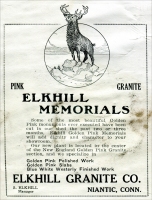
Commercial use of material within this site is strictly prohibited. It is not to be captured, reworked, and placed inside another web site ©. All rights reserved. Peggy B. and George (Pat) Perazzo.
Brennan Stone Co.
Granite, Limestone, Bluestone, Brownstone, Ohio Sandstones and Marble
Main Office and Mill - 208 Housatonic Ave., Bridgeport, Conn., Tel. Barnum 3148
Hartford Plant, Edwards St., Hartford, Conn., Tel. 2-5390
| A. Malnati, Quarry Owner & Manufacturer of Monuments (Advertisement from The Monumental News, April 1903, pp. 227) |  |
| A. Malnati, Quarry Owner and Manufacturer of Artistic Monuments, Quincy, Massachusetts. Quarries at East Lyme, Connecticut. (photo caption in ad) “…this tablet in Golden Pink Granite.” | 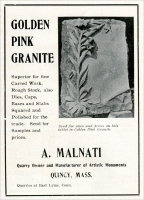 |
 |
Malnati's Golden Pink Granite Quarries located near East Lyme, Connecticut, Granite, Marble, Bronze, May 1923. |
The caption reads: "Maximum relief of carving, 2 ¾ inches; height of cross, 12 feet."

